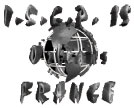15th International Symposium on Plasma Chemistry, ISPC-15
9-13 July 2001, Orl�ans, France.
> Back to Calendar
 The
15th International Symposium on Plasma Chemistry, ISPC-15, was held
in Orléans, France, from 9-13 July 2001. The Symposium was
hosted by the laboratory GREMI (Groupe de Recherche sur l'Énerge-tique
des Milieux Ionisés) at the University of Orléans,
and was organized by an International Organizing Committee and a
Local Organizing Committee, chaired respectively by A. Bouchoule
and J. M. Pouvesle, both of GREMI. The 610 registered attendees
came from 40 countries. Countries with the highest number of attendees
included France (218), Japan (90), Germany (48), Russia (32), the
United States (32), Czech Republic (31), Canada (26), Italy (20),
Poland (16) and the Netherlands (12). The Symposium was preceded
by the biennial International Summer School on Plasma Chemistry,
held 4-6 July, and a Workshop on Industrial Applications of Plasma
Processing, on 7 July, both of which were well attended.
The
15th International Symposium on Plasma Chemistry, ISPC-15, was held
in Orléans, France, from 9-13 July 2001. The Symposium was
hosted by the laboratory GREMI (Groupe de Recherche sur l'Énerge-tique
des Milieux Ionisés) at the University of Orléans,
and was organized by an International Organizing Committee and a
Local Organizing Committee, chaired respectively by A. Bouchoule
and J. M. Pouvesle, both of GREMI. The 610 registered attendees
came from 40 countries. Countries with the highest number of attendees
included France (218), Japan (90), Germany (48), Russia (32), the
United States (32), Czech Republic (31), Canada (26), Italy (20),
Poland (16) and the Netherlands (12). The Symposium was preceded
by the biennial International Summer School on Plasma Chemistry,
held 4-6 July, and a Workshop on Industrial Applications of Plasma
Processing, on 7 July, both of which were well attended.
The
high quality of the presentations and the range of topics demonstrated
the extraordinary vitality of the field of plasma chemistry. Over
550 papers were presented at the symposium, including 133 oral presentations
and 420 posters. Presentations were grouped into major topical areas,
which included fundamentals of and basic processes in each of thermal
plasmas and non-equilibrium plasmas; sources, diagnostics and modeling
in each of atmospheric pressure non-equilibrium plasmas, thermal
plasmas, and low-pressure plasmas; plasma chemical vapor deposition
of silicon-based compounds; inorganic films and hard coatings; plasma
deposition and treatment of polymers; etching and micro-technology;
plasma sprays and thermal plasma material processing; clusters,
particles and powders; environmental applications of each of thermal
plasmas and non-equilibrium plasmas; plasma chemical synthesis/engineering;
and laser-based technologies and plasma light sources. The full
conference proceedings, edited by A. Bouchoule, J. M. Pouvesle,
A. L. Thomann, J. M. Bauchire and E. Robert, comprise eight volumes
and more than 3000 pages.
There
were seven plenary lectures, given by C. H. Kruger,
Stanford University, US, on non-equilibrium discharges in air at
atmospheric pressure; D. C. Schram, Eindhoven University of Technology,
the Netherlands, on plasma processing and chemistry; M. Sekine,
Association of Super Advanced Electronics Technologies, Japan, on
future plasma technologies in ULSI processing; J. Heberlein,
University of Minnesota, US, on new approaches in thermal plasma
technology; S. De Benedictis, University of Bari, Italy, on energy
transfers by long-lived species in glows and afterglows; P. Roca
i Cabarrocas, École Polytechnique, France, on plasma production
of polymorphous silicon thin films; and M. Moisan,
University of Montreal, Canada, on plasma sterilization.
The
plenary and invited papers will be published in Pure and Applied
Chemistry, edited by A. Bouchoule.
The
conference banquet was held at the magnificent Chateau de Blois.
At the banquet the Plasma Chemistry Award was presented to Prof.
Pierre Fauchais, of the University of Limoges, France. The Plasma
Chemistry Award is the major award of the plasma chemistry community
for career achievement. Prof. Fauchais was recognized for his outstanding
contributions in the areas of thermal plasmas, plasma spraying,
optical diagnostics, and modeling. In 1968 Prof. Fauchais founded
the group on "Procédés de traitements de surface,
" which is part of the CNRS laboratory SPCTS at the University of
Limoges. Prof. Fauchais continues to direct this group, which has
educated a large number of plasma scientists and engineers. In addition
he has a distinguished record of service to the plasma chemistry
community, having organized a number of conferences and having served
on the IUPAC Subcommittee on Plasma Chemistry.
Best
Paper Awards were presented to three young plasma scientists: Nicolas
Gherardi, Université Paul Sabatier, Toulouse, France, for
his paper on light emission in a glow dielectric barrier discharge
in nitrogen; Matthias Meier, Max Planck
Institute
for Plasma Physics, Garching, Germany, for his paper on formation
of polymer-like hydrocarbon films from beams of methyl radicals
and hydrogen atoms; and Masako Shindo, Kyushu University, Japan,
for her work on the role of negative ions in an oxygen-argon electron
cyclotron resonance plasma.
A
major event at the Symposium was the founding of a new society,
the International Plasma Chemistry Society (IPCS). The first meeting
of the General Assembly of the IPCS, consisting of all attendees
of IPSC-15, was held during the Symposium on 11 July 2001. At this
meeting the Statutes of Foundation and Rules of Governance of the
new Society were adopted.
I
was elected for a two-year term as President of the IPCS and Chair
of the Board of Directors. J. Winter, of the University of Böchum,
Germany, was elected as Vice-Chair.
The
next International Symposium on Plasma Chemistry, ISPC-16, is planned
for Taormina, Italy, 22-27 June 2003. The Symposium will be hosted
by R. d'Agostino,
P. Capezzuto, and colleagues at the University of Bari, Italy.
by Steven L. Girshick
Professor in the High Temperature
and Plasma Laboratory, Department of Mechanical Engineering at the
University of Minnesota.
> Published in Chem.
Int. 24(1),
2002

